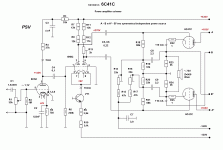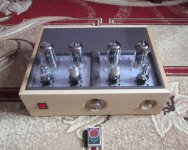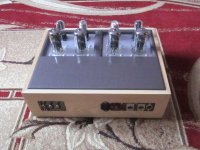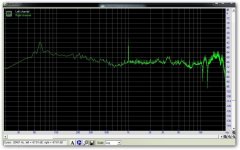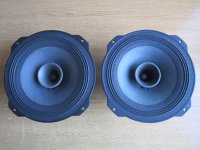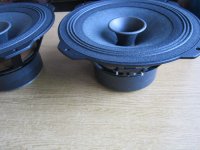sreten, Charcoal, as far as I know, this nonsense
does not apply to kits for the construction.
Hi,
That was my point, its strictly DIY territory, and
unusual DIY valve amplifier topology to boot.
A tiny market, anyway you look at it.
A major limitation, and a killer for manufacturing
at a cost effective quantity level. Any business
that can fly would produce the drivers at normal
impedances and have high impedance specials.
rgds, sreten.
Eliminating the output transformer creates problems
for push-pull - the driver would need to be centre-
tapped and offhand I don't know if it could handle
the typical bias currents used in valve amplifiers.
Last edited:
Hi,
Eliminating the output transformer creates problems
for push-pull - the driver would need to be centre-
tapped and offhand I don't know if it could handle
the typical bias currents used in valve amplifiers.
A Single ended or push pull parafeed arrangement might be useful in this situation.
Be able to share photos of your 800 ohm Phillips?I do own a pair of Philips 3800 AM and 3700 AM both pairs rated 800 Ohm impedance.
Am sorry, but I don't have equipment to make a measurement as proposed.
Thank you.
Requirements for cords amplifier - speaker as the supply cord 220V/50Hz.As for the standard, I have been told that approval for sale of the Philips amplifiers was difficult due to high voltages in speaker-cords. If a cat bit the cord, it could easily pay the ultimate price.
For 2000 Ohms, voltages will be even higher to drive the speakers, so maybe there is a commercial restance-range, that is applicable?
Am hoping to hear more about this great initiative, allthough the Qts is pretty high and is maybe best with a sealed box enclosure?
Thank You for answering. Much appreciated!
Not understand the cause of problems.
It is possible that 2000 ohms maximum sufficient resistance. Or is it close to the edge. For the direct heat of tubes enough.
Speaker will be working in an enclosed volume of 60 liters.
Calculated rise on high, 70-5 Hz, about 3-4 dB.
Confident from 35-40 Hz.
Push-pull circuit of message 5 works quite stable.Hi,
...Eliminating the output transformer creates problems
for push-pull - the driver would need to be centre-
tapped and offhand I don't know if it could handle
the typical bias currents used in valve amplifiers.
Driver 6SN7GT (6Н8С) cope.
The highlight of the complex - close to a resistive load of the amplifier.
Last edited:
Hello Svjatoslav.
As for pictures, I take the easy way and point to the Internet for an eBay auction, which I am in no way afiliated with. But it has very good pictures of the 4 Ohm version of Philips AD 3800. They are completely alike the ones I have, Except for typenumber of high Ohm version which AD 3800 AM. Look here:
Philips Full Range Speakers AD3800 | eBay
There is also a lead from negative pole to chassis on the high-Ohm version. Probably to avoid humm and other noise induction.
I measured ohmic resistance with my cheap multimeter. It reads 574 Ohm and 578 Ohm for the other one.
As for pictures, I take the easy way and point to the Internet for an eBay auction, which I am in no way afiliated with. But it has very good pictures of the 4 Ohm version of Philips AD 3800. They are completely alike the ones I have, Except for typenumber of high Ohm version which AD 3800 AM. Look here:
Philips Full Range Speakers AD3800 | eBay
There is also a lead from negative pole to chassis on the high-Ohm version. Probably to avoid humm and other noise induction.
I measured ohmic resistance with my cheap multimeter. It reads 574 Ohm and 578 Ohm for the other one.
And if you go active and integrate the amp into the speaker box would that be legal or save?Hi,
You can't develop the "standard". It will always
be illegal in terms of consumer products to sell
an amplifier that can drive your speaker units,
with any form of current speaker connection.
Stupid but true AFAIK.
rgds, sreten.
I don't know what the actual voltage limits are.
Hello, otc.Hello Svjatoslav.
As for pictures, I take the easy way and point to the Internet for an eBay auction, which I am in no way afiliated with. But it has very good pictures of the 4 Ohm version of Philips AD 3800. They are completely alike the ones I have, Except for typenumber of high Ohm version which AD 3800 AM. Look here:
Philips Full Range Speakers AD3800 | eBay
Thank you.
I have a picture in front of 400 ohm version. From colleagues.
Picture is similar.
Now I know that the design of the magnetic circuit AD 3800 AM . He is seen in the photo's "back."
Would love to know its impedance at different frequencies and frequency response. Certainly some of our colleagues know her, or
I have a picture in front of "350 ohm" version. From colleagues.
Picture is similar.
Now I know that the design of the magnetic circuit AD 3800 AM . He is seen in the photo's "back".
Would love to know its impedance at different frequencies and frequency response. Certainly some of our colleagues know her, or measured. )))
Can you share your amplifier circuit for AD 3800 AM?
What are his options?
Thank you.
May conclude from the negative pole is needed to protect against electrical breakdown. Through the air gap.There is also a lead from negative pole to chassis on the high-Ohm version. Probably to avoid humm and other noise induction.
I measured ohmic resistance with my cheap multimeter. It reads 574 Ohm and 578 Ohm for the other one.
Magnetic circuit AD 3800 AM conductive.
In my design details of the magnetic circuit is electrically isolated.
To AD 3800 AM: 800/576 = 1.39. Impedance increases rapidly.
Version the speaker of high-resistance 900 ohms at 1 kHz, impedance Z = 1,20-1,25Re.
To AD 3800 AM: 800/576 = 1.39. Impedance increases rapidly.
Characteristics of the attachment.
(Point F2z is at 80 kHz!))))
Attachments
Hello Svjatoslav,
You can download the whole servicebook for the Philips AG9015 amplifier. It uses output-capacitors, though.... max. output in to 800 Ohm is 15 Watt.
Here: AG9015 pdf free ebook download from frank.pocnet.net
There are other Philips amps from the period which might be more interesting for You. AG9006, AG9009 and AG9013. You can find servicebooks for download by searching on the name Philips, typenumber and .PDF.
The impedance-measurements. Would it take:
A sine-wave frequency-generator? Like a software-based on my PC.
A voltmeter in parallel with speaker, to help set voltage to 2,83 Volts for each measuringpoint.
An ampmeter in series to measure current for each measurepoint.
Would this do it?
otc
You can download the whole servicebook for the Philips AG9015 amplifier. It uses output-capacitors, though.... max. output in to 800 Ohm is 15 Watt.
Here: AG9015 pdf free ebook download from frank.pocnet.net
There are other Philips amps from the period which might be more interesting for You. AG9006, AG9009 and AG9013. You can find servicebooks for download by searching on the name Philips, typenumber and .PDF.
The impedance-measurements. Would it take:
A sine-wave frequency-generator? Like a software-based on my PC.
A voltmeter in parallel with speaker, to help set voltage to 2,83 Volts for each measuringpoint.
An ampmeter in series to measure current for each measurepoint.
Would this do it?
otc
Hello, otc.
Thanks for the help to find a scheme.
Measured in constant current mode. Ballast 200Re = 470 000 ohms.Or more. Require a relatively large measurement voltage. I am using external measuring system. Individual instruments - current generator and voltmeter.
Will the standard program output from the computer - I do not know. But You can try.
Thanks for the help to find a scheme.
Measured in constant current mode. Ballast 200Re = 470 000 ohms.Or more. Require a relatively large measurement voltage. I am using external measuring system. Individual instruments - current generator and voltmeter.
Will the standard program output from the computer - I do not know. But You can try.
Cyclotron produced on tubes 6C41C, stereo.
Output power at load 500 Ohm (full-range speaker) 12 Вт
Band power 7Hz - 125 kHz
Slew rate of 55 V / us
Signal / background (noise) relative to the maximum output voltage of - 81 dB.
Dimensions (not including the height of tubes) 41x310x135 mm.
Output power at load 500 Ohm (full-range speaker) 12 Вт
Band power 7Hz - 125 kHz
Slew rate of 55 V / us
Signal / background (noise) relative to the maximum output voltage of - 81 dB.
Dimensions (not including the height of tubes) 41x310x135 mm.
Attachments
Review, summarizing the overall experiences of many listeners:
"Thus , the overall impression.
After switching on the amplifier enters somewhere after 15 - 20 min . , Although auditory sensations it is almost invisible and you can of course listen to immediate use. Background barely tapped by 60 - 80 % level on the volume , it is given almost total silence room.
High frequencies are very beautiful, no sand and more than plenty, I did discover some opening in one of the songs I had never heard bells, they turned out there . Mids are of course the upper class, and who would doubt , each instrument clearly defined, there is no hash ( especially listening to instrumental music ) . Very good channel separation , there is no effect on the penetration of adjacent channels . With regard to the lower classes , as I said above the AU did not allow you to fully enjoy all the charm , but I think they will reveal itself fully when using the correct speaker. Next, loved the attack sound really speed - rise and fall times are felt . But the most interesting thing I have not heard until now in amplifiers ( will listen to them quite a few ) , it's an amazing scene depth . I even thought for a second that I was sitting on the actual live performance. Soloist , was clearly in the foreground , each instrument has its place , it is absolutely clear auditioned middle and background . Interestingly , even the fact that I was trying to go a little bit away from the stereo , however , the lead singer remained exactly in the center . I even said to Sergei at a time where he had hidden it in the nightstand third speaker - front laughed of course, but the feeling that the middle of the front speakers is purely for the soloist , and left.
These are purely subjective impressions . Without going into the intricacies and peculiarities of circuit solutions UM , I think that the only difficulty in the implementation of this project is to calculate the optimal production and the AU , as This mind listening to an impromptu speaker , will certainly want to hear the beauty of the sound to the fullest, the whole frequency range stated by the author."
"Thus , the overall impression.
After switching on the amplifier enters somewhere after 15 - 20 min . , Although auditory sensations it is almost invisible and you can of course listen to immediate use. Background barely tapped by 60 - 80 % level on the volume , it is given almost total silence room.
High frequencies are very beautiful, no sand and more than plenty, I did discover some opening in one of the songs I had never heard bells, they turned out there . Mids are of course the upper class, and who would doubt , each instrument clearly defined, there is no hash ( especially listening to instrumental music ) . Very good channel separation , there is no effect on the penetration of adjacent channels . With regard to the lower classes , as I said above the AU did not allow you to fully enjoy all the charm , but I think they will reveal itself fully when using the correct speaker. Next, loved the attack sound really speed - rise and fall times are felt . But the most interesting thing I have not heard until now in amplifiers ( will listen to them quite a few ) , it's an amazing scene depth . I even thought for a second that I was sitting on the actual live performance. Soloist , was clearly in the foreground , each instrument has its place , it is absolutely clear auditioned middle and background . Interestingly , even the fact that I was trying to go a little bit away from the stereo , however , the lead singer remained exactly in the center . I even said to Sergei at a time where he had hidden it in the nightstand third speaker - front laughed of course, but the feeling that the middle of the front speakers is purely for the soloist , and left.
These are purely subjective impressions . Without going into the intricacies and peculiarities of circuit solutions UM , I think that the only difficulty in the implementation of this project is to calculate the optimal production and the AU , as This mind listening to an impromptu speaker , will certainly want to hear the beauty of the sound to the fullest, the whole frequency range stated by the author."
Last edited:
Voice coils are made to order, using special equipment, according to my drawings.
If You notice, these speakers have very low inductance. It is much lower than that of their counterparts of low resistance.
I am interested in such speakers. Could you write where I can order them? I speak Russian, so it is not the problem. But since it it english language forum let's use it.
You can order them from me. Several couples are in Russia and other countries.
One of the users measured frequency response (the attachment).
On an example of resistance of 1000 ohm speakers.
Measuring system is not outstanding. But in the first approximation gives opportunity to see in the high frequency characteristics.
As you can see, 500 Hz and 20 kHz are played on the same average level.
The attachment photo next pair of speakers nominal impedance of 2000 ohms.
Will be measured more sophisticated measuring complex.
One of the users measured frequency response (the attachment).
On an example of resistance of 1000 ohm speakers.
Measuring system is not outstanding. But in the first approximation gives opportunity to see in the high frequency characteristics.
As you can see, 500 Hz and 20 kHz are played on the same average level.
The attachment photo next pair of speakers nominal impedance of 2000 ohms.
Will be measured more sophisticated measuring complex.
Attachments
The cost of a pair of speakers 1 kOhm - 360 USD. This resistance (1 kOhm) basic. As is consistent with the majority of tubes with a low internal resistance.
Costs for packaging and shipment to the United States 68, Russia - 55, Denmark - 52 USD . Speakers are made in pairs, with similar parameters.
Each speaker has its own number. Thiele-Small parameters are applied to the description and photos. It's all agreed with the customer prior to shipment.
Costs for packaging and shipment to the United States 68, Russia - 55, Denmark - 52 USD . Speakers are made in pairs, with similar parameters.
Each speaker has its own number. Thiele-Small parameters are applied to the description and photos. It's all agreed with the customer prior to shipment.
Would like to add, that I found information of reactive resistance of 26 - 30 mHy, measured at 1 kHz on another HP.
I don't have any info of the measuring setup.
I know You would like to see it measured over an extended frequency range but still have no info of that...
That is for the Philips AD3800AM speakers!
I can add that my set have an Fs of 90 Hz. No real bass to be obtained.
- Status
- This old topic is closed. If you want to reopen this topic, contact a moderator using the "Report Post" button.
- Home
- Loudspeakers
- Full Range
- Speakers full-range with a high resistance.

